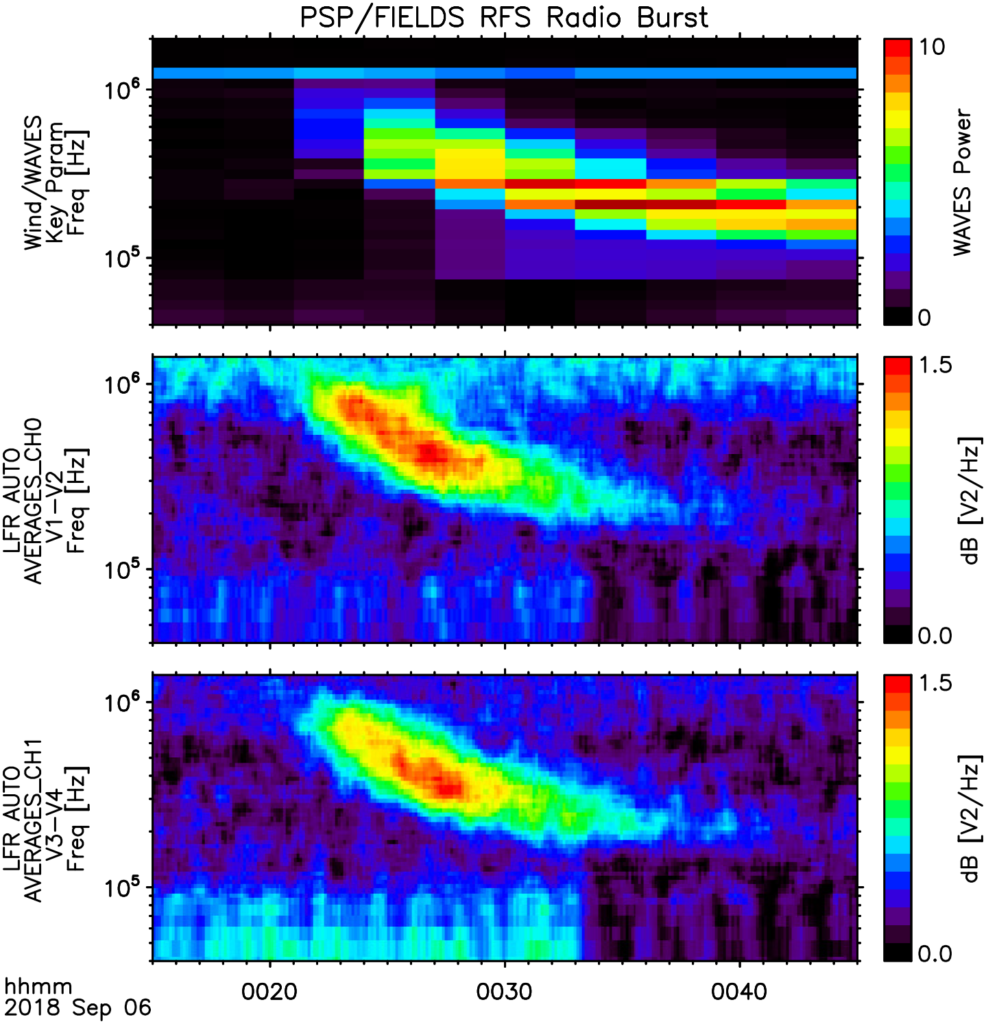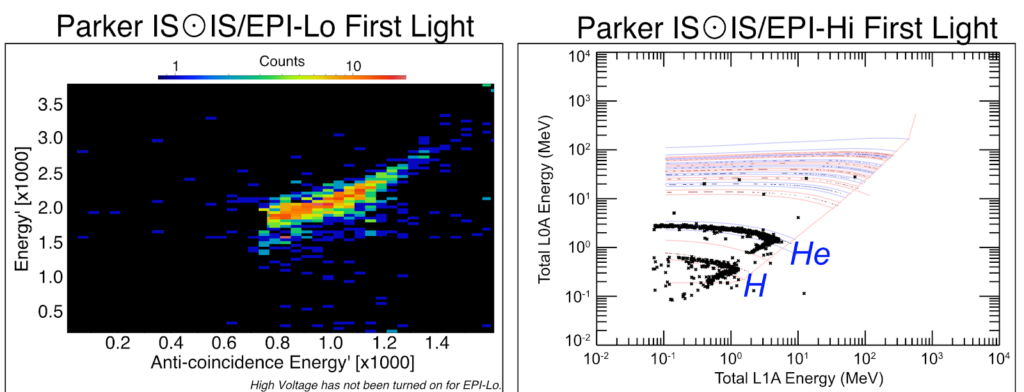KENNEDY SPACE CENTER, FL – Just a month after blastoff from the Florida
Space Coast, NASA’s Parker Solar Probe has captured ‘First Light’ images from
all four of its science instruments – including stunning
views of the Milky Way – confirming that they are all functioning
well on humanity’s first mission to ‘Touch the Sun.’
As of today Parker is more than 26 million
miles (41 million km) from Earth.
 |
|
Parker Solar Probe Mission Trajectory and Current Position. Credit: NASA/APL/Parker Solar Probe
|
instruments ready and commissioned in time for the 1st Venus flyby and
1st solar perihelion” set for November 5, 2018, said Nicki Fox, now director
of NASA’s Heliophysics Division in a post launch interview with Space UpClose at the Kennedy
Space Center. Fox served previously as Parker
project scientist at APL.
The calibration and checkout data demonstrate
that “each of the instruments is working well” says NASA.
For example, the lead image above was captured
by the WISPR instrument, short
for the Wide-field Imager for Parker Solar Probe, on Sept. 9,
2018.
The left side of the beautiful image shows the
Milky Way looking at the galactic center from WISPR’s outer telescope. It has a 58-degree field of view and extends
to about 160 degrees from the Sun.
Jupiter is visible near the center of the right
side image from WISPR’s inner telescope.
It has a 40-degree field of view and extends 58.5 degrees from the Sun’s
center on the right side edge.
There is a parallax of about 13 degrees in the
apparent position of the Sun as viewed from Earth and from Parker Solar Probe.
“All instruments returned data that not only
serves for calibration, but also captures glimpses of what we expect them to
measure near the Sun to solve the mysteries of the solar atmosphere, the
corona,” said Nour Raouafi, Parker Solar Probe project scientist at the Johns
Hopkins University Applied Physics Lab in Laurel, Maryland, in a statement.
“The instruments work in tandem to measure the
Sun’s electric and magnetic fields, particles from the Sun and the solar wind,
and capture images of the environment around the spacecraft.”
Here’s a description of WISPR from Russ Howard,
principal investigator from the Naval Research Laboratory. He studied the
images to determine the instrument was pointing as expected, using celestial
landmarks as a guide.
“There is a very distinctive cluster of stars
on the overlap of the two images. The brightest is the star Antares-alpha,
which is in the constellation Scorpius and is about 90 degrees from the Sun,”
said Howard.
The Sun, not visible in the image, is far off
to the right of the image’s right edge. The planet Jupiter is visible in the
image captured by WISPR’s inner telescope — it’s the bright object slightly
right of center in the right-hand panel of the image.
“The left side of the photo shows a beautiful
image of the Milky Way, looking at the galactic center,” said Howard.
The exposure time – i.e. the length of time
that light was gathered for this image, an interval which can be shortened or
lengthened to make the image darker or brighter – is on the lower end, and
there’s a reason: “We intentionally wanted to be on the low side in case there
was something very bright when we first turned on, but it is primarily because
we are looking so far from the Sun,” explains Howard.
As the spacecraft approaches the Sun, its
orientation will change, and so will WISPR’s images. With each solar orbit,
WISPR will capture images of the structures flowing out from the corona. While
measurements have been made before by other instruments at a distance of 1 AU –
or approximately 93 million miles – WISPR will get much closer, about 95% of
the way to the Sun from Earth, dramatically increasing the ability to see
what’s occurring in that region with a much finer scale than ever before and
providing a more pristine picture of the solar corona.
 |
|
The FIELDS instrument
suite aboard Parker Solar Probe captures the scale and shape of electric and magnetic fields in the Sun’s atmosphere. This plot was updated on Sept. 21, 2018, to better illustrate the comparison between Parker Solar Probe’s data (center and bottom) and the data from the Wind mission (top). Both versions are available from NASA’s Scientific Visualization Studio. Credit: NASA/UC Berkeley/Parker Solar Probe/Wind |
NASA’s daring Parker Solar Probe mission will fly
at never before attained speeds through the hellish atmosphere of our Sun’s
corona for the first time in human history.
Parker will travel at
unprecedented speeds of up to 430,000 MPH, some 700,000 kph as at swings by the
sun 24 times over the next 7 years via orbits shaped by 7 flybys of Venus.
The team must work expeditiously because the
first Venus flyby will take place on Oct. 3, 2018, at 4:44 a.m. EDT and the first
perihelion flyby of the Sun on Nov. 5, 2018, at 10:27 p.m. EST (Nov. 6, 2018,
at 03:27 UTC).
“The spacecraft will use Venus to slightly
slow itself and adjust its trajectory for an optimal path toward first
perihelion of the Sun on Nov. 5, 2018.”
The mission began with a dazzling
middle-of-the-night blastoff of the mighty Delta IV Heavy rocket in the wee
hours of Sunday morning, Aug. 12 – and delivered the car sized spacecraft to its
intended trajectory towards Venus and the Sun.
The 23-story tall triple barreled United
Launch Alliance Delta IV Heavy rocket successfully launched at 3:31 a.m. EDT
Aug. 12 from the Florida Space Coast and put on a brilliant display of fire
power with 2.1 million pounds of thrust spewing forth from the trio of liquid
oxygen/liquid hydrogen RS-68A main engines that quickly turned night into day a
few hours before Sundays natural sunrise under nearly cloud-free skies.
Check out our Space UpClose gallery of photos
and videos. Plus my BBC TV World News prelaunch interview.
Here’s my Parker launch video
from a remote camera set at pad 37:
Video Caption: Launch of NASA’s Parker Solar Probe on United Launch Alliance
Delta IV Heavy rocket on Aug. 12, 2018, at 3:31 a.m. EDT from Launch
Complex 37 at Cape Canaveral Air Force Station, Florida on humanity’s 1st
mission to our sun that will fly through the sun’s atmosphere or corona – as seen in this remote camera video taken at the pad. Credit:
Ken Kremer/kenkremer.com/spaceupclose.com
Here’s my BBC TV World News Pre-Launch
interview:
Watch for Ken’s continuing onsite coverage of NASA, SpaceX, ULA,
Boeing, Lockheed Martin, Orbital ATK and more space and mission reports direct
from the Kennedy Space Center, Cape Canaveral Air Force Station, Florida and
Wallops Flight Facility, Virginia.
Stay tuned here for Ken’s continuing Earth and Planetary science and human
spaceflight news: www.kenkremer.com
–www.spaceupclose.com – twitter @ken_kremer – email: ken at kenkremer.com
Dr. Kremer is a research scientist and journalist based in the
KSC area.
Ken’s photos are for sale and he is available for lectures and outreach events





